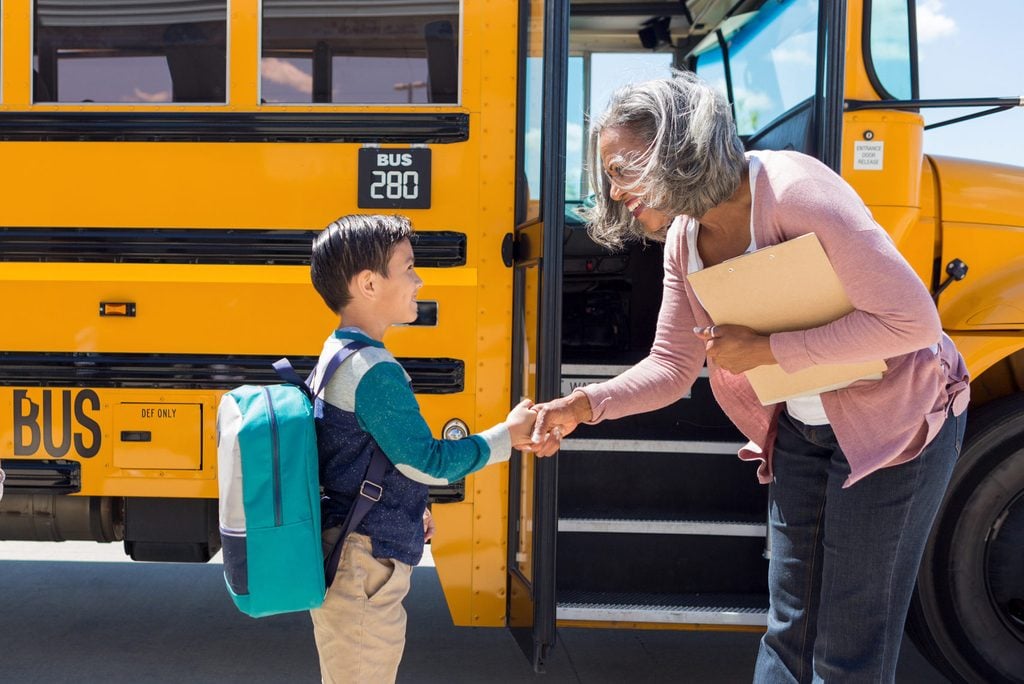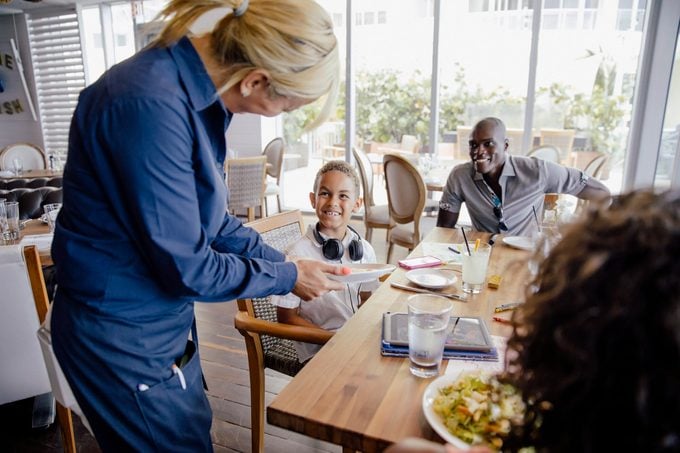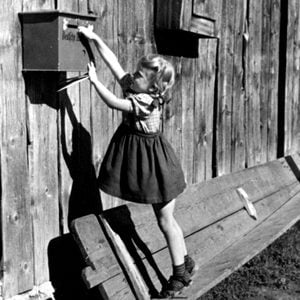16 Forgotten Manners Every Parent Should Teach Their Child
Updated: Dec. 15, 2023

Saying "please" and "thank you" is just the tip of the iceberg.
There’s a serious generation gap when it comes to etiquette rules. Three-quarters of Americans said they think manners and behavior have deteriorated in the United States over the past several decades, according to a survey by the Associated Press-NORC Center for Public Affairs. One example: 50 percent of young adults think it is perfectly acceptable to use cell phones in restaurants, while only 20 percent of people over 60 years old agree.
Why manners matter
This is a bigger problem than just dinner-table arguments; an important part of raising your child is teaching them good manners as it helps them be more successful in life and sets a civil tone in society, says Jodi R. R. Smith, founder of Mannersmith Etiquette Consulting. Lacking basic manners will affect kids in all areas of their lives. Take, for instance, these etiquette rules that should be taught in schools but aren’t.
How to teach children manners
Teaching manners doesn’t have to be a fight, Smith says. She recommends five simple steps to raise polite adults(Discover these things that polite people always say.):
- Practice at home. Prepare children in advance for different situations so they won’t be surprised in the moment.
- Have age-appropriate expectations. Know what your child is capable of learning and doing at each stage of life. Parents are often surprised by what their kids can handle when given the chance.
- Set a good example. Kids are the best mimics so mind your own manners, even if you think they’re not watching.
- Skip threats and punishments. They don’t work and positive reinforcement is more effective in the long run. (Using threats is a sign that you might be a toxic parent.)
- Keep the conversation going. Make sure your kids know they can always come to you with questions.
Forgotten manners all modern children should know
These etiquette rules used to be considered basic knowledge but are much rarer these days. Making sure your modern kids know these “old-fashioned” manners will set them ahead of their peers (and many adults).
Know when to turn off the phone
Most kids, even many young ones, have their own smartphone or ready access to a parent’s which means they need to be taught cell phone etiquette as soon as they are old enough to hold one says, Adeodata Czink, etiquette expert and founder of Business of Manners. This starts with knowing when to turn it off or silence it and put it out of sight, like in movie theaters, places of worship, birthday parties, and family dinners.
Saying “you’re welcome”
Remembering to say “please” and “thank you” is a great start but you should also be teaching your kids how to politely accept a thank-you, Czink says. “Many children will say ‘no problem,’ ‘whatever,’ ‘OK’, or not reply at all when thanked,” she says. “The proper response is to say ‘you’re welcome’ or even ‘my pleasure.'” Parents, make sure you avoid giving these 8 compliments that are actually harmful to your child.
Small acts of service
It’s the little acts of kindness that help society run smoothly. Things like holding doors open, picking up dropped items, or letting someone go first in line go a long way, Czink says. Think of small acts of polite service that even young children can do for adults and other kids. Of course, teach them to do it in a safe way, when an adult they know is present, and don’t force them to interact with strangers they are uncomfortable with.
Saying “thank you” to service workers

Saying “thank you” is the bedrock of all good manners but these days many children (and adults!) overlook thanking the people that help them in many little ways each day, like waitstaff, store clerks, teachers, and bus drivers. It’s not just about politeness but about teaching children to recognize and acknowledge others’ contributions as valuable. “Ultimately it’s about teaching them not to treat other people as if they are their servants,” Czink says.
Giving up their seat
Giving up a seat to an elderly or pregnant person used to be commonplace but these days many people prioritize their child’s comfort over others. Unless they are very young or ill, most children are perfectly capable of standing for a period of time (they may even prefer it!) and this is the perfect opportunity to teach them to show kindness and think of others, Czink says. This is a particularly good reminder for tweens and teens who may not be looking for those around them who need help.
RSVP’ing to an event
It’s true that invitations have gotten a lot more casual these days but whether you get an evite or a paper card, it’s still important to RSVP so the host can prepare, says Maryanne Parker, professional etiquette coach and author of Manor of Manners. There are many reasons a child may balk at replying: they may prefer to hedge their bets and wait for a more exciting invitation, they may not want to talk to or phone the host, they may be distracted or forgetful, or they may not want to say no and disappoint. Regardless of the reason, it’s more important than ever to teach your children to RSVP promptly as a sign of basic respect and gratitude for being invited, she says.
Waiting to eat until everyone is seated and served
Whether you’re dining at home or in a restaurant, the proper etiquette is still to wait to begin eating the meal until everyone is served, Parker says. Many people are under the impression that children should always get to eat right away but even very young kids can be taught to wait several minutes for everyone else.
Using their indoor voices
Crying, laughing, or just talking, children can be very loud. A parent should teach their child early on how to moderate their volume and tone based on the situation, Parker says. You can make it into a fun game for little ones, like seeing who can whisper the quietest in a church. Then learn 10 habits of parents who raise successful children.
Taking turns talking
Kids are natural interrupters but while their desire for your attention is normal and appropriate, their need to get it at the expense of others in the conversation is not. Teach your child to tap your arm and then wait patiently for you to acknowledge them before speaking, Parker says. If they do interrupt, calmly tell them it’s rude to interrupt and let them know you’ll acknowledge them shortly. Remember it goes both ways; offer your child the same courtesy and don’t interrupt them when it’s their turn to talk.
Making polite observations
Telling Uncle Floyd he looks pregnant or asking a stranger why they have polka dots (acne) on their face is developmentally appropriate behavior for young kids learning about their world. However, they need to be taught that their words impact others and they can cause hurt feelings by commenting on people’s appearances, says Lisa Grotts, etiquette expert, founder of Golden Rules Gal. Compliments are fine but talking about other people’s appearance in public should be off-limits. Teach them that when in doubt, they should wait until they can tell you in private.
Covering a cough or sneeze

These days it’s more important than ever to teach children to cough or sneeze into a tissue or their elbow, Grotts says. It’s not just a matter of hygiene—no one enjoys getting sprayed—but it is also a way to help others feel safe and comfortable around you. “Don’t forget to teach them to say ‘excuse me’ after,” she adds. This is one of the 25 etiquette mistakes everyone should stop making before they turn 30.
Writing thank-you notes or texts
Gift-givers like to know that their gift was received and that the recipient enjoyed it. Children of all ages should be taught to write or draw a thank-you card when they receive a present, Grotts says. Another modern option is to send a thank-you text or email, preferably with a cute picture of the kiddo holding the gift or a thank you sign.
Using good social (media) etiquette
Unless they are very young, most kids are on social media these days and that means they need to be taught the dos and don’ts of social interactions online, Grotts says. This could be its own article but the basics include not posting pictures of or tagging other people without their permission, never giving out personal information, and never saying anything online that you wouldn’t say in person.
Introducing themselves
Many children balk at making eye contact or speaking with people they don’t know and will need to be taught how to greet others politely. “The ideal way to introduce oneself is to make eye contact, extend your hand for a handshake, and smile warmly,” Grotts says, adding that this is true for children and adults. However, if shaking hands isn’t encouraged (like during the pandemic) or a child doesn’t feel comfortable touching someone else, a nod or elbow bump is perfectly acceptable.
Being on time
Even though kids can’t drive they can and should be taught the importance of being prepared and on time, Grotts says. Not only will it help their day run more smoothly but it’s a sign of respect to their classmates, playdates, teachers, and family members. With children, this means teaching them how to manage transitions from one activity to the next, learning to tell time, and always putting away things like shoes and coats.
Speaking on the phone
The younger generation may be more adept at using smartphones but older people generally have better phone manners, particularly when it comes to speaking on the phone. It’s alarming how many children don’t know the basics of conversing on the phone, Czink says. Teach them to answer a call with “hello” and to say something to end it rather than just hanging up the phone or handing it back to an adult. Demonstrate to your child how to start a phone call, introduce yourself, and how to take turns speaking. Make sure they know how to handle video calls as well. Find out the 15 etiquette rules that have changed in the last decade.
Sources:
- Associated Press-NORC Center for Public Affairs: Rude Behavior in Everyday Life and on the Campaign Trail
- Jodi R. R. Smith, founder of Mannersmith Etiquette Consulting
- Adeodata Czink, etiquette expert and author of Business of Manners
- Maryanne Parker, professional etiquette coach and author of Manor of Manners
- Lisa Grotts, etiquette expert, founder of Golden Rules Gal
- Associated Press: “Rude Behavior in Everyday Life and on the Campaign Trail”


